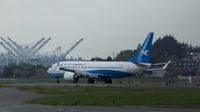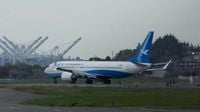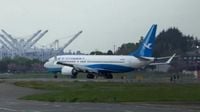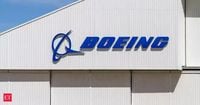In a striking development amidst ongoing trade tensions between the United States and China, a Boeing 737 MAX jet, originally intended for Xiamen Airlines, has made its way back to the U.S. after being almost fully completed at a finishing facility in Zhoushan, China. This aircraft's return marks a significant moment in the escalating tariff war that has disrupted the aerospace industry.
On Saturday evening, April 19, 2025, the Boeing 737 MAX, adorned with the livery of Xiamen Airlines, landed at Boeing Field in Seattle at 6:11 p.m. This return came shortly after the Chinese government instructed its airlines to halt any further orders from U.S.-based aerospace manufacturers, a decision that left many in the industry questioning the future of their contracts.
The aircraft's journey back to the U.S. was not without its complexities. It made refueling stops in Guam and Hawaii during its 5,000-mile (8,000-km) trek across the Pacific. The return of this jet is seen as a direct consequence of the trade war initiated by the Trump administration, which imposed a staggering 145% baseline tariff on Chinese imports. In retaliation, China enacted a 125% tariff on U.S. goods, creating a tumultuous trading environment.
While the exact reasons for the jet's return remain unclear, neither Boeing nor Xiamen Airlines has publicly commented on the matter. This lack of clarity only adds to the confusion surrounding the changing landscape of aircraft deliveries. Earlier in the week, President Donald Trump took to social media to express his concerns, stating, "China just reneged on the big Boeing deal, saying that they will ‘not take possession’ of fully committed to aircraft."
China's directive for its airlines came during a week of heightened tensions, as the Chinese Ministry of Foreign Affairs spokesperson Lin Jian stated during a press conference on April 16 that he was "not familiar with" any formal announcement telling airlines to refuse deliveries from Boeing. However, the timing of the directive and the return of the aircraft suggests a coordinated response to the tariffs.
In addition to the 737 MAX jet that returned to Seattle, reports indicate that a trio of other 737 MAX 8 jets that were being prepared for delivery were also recalled to the U.S. last week. These developments underscore the broader implications of the trade war on Boeing's operations and its relationships with Chinese airlines.
Despite these setbacks, Boeing's year-to-date delivery statistics reveal that the company has successfully delivered 18 aircraft to nine airlines in China thus far in 2025. Major carriers such as Air China, China Eastern Airlines, and China Southern Airlines still have substantial orders pending, with plans to take delivery of 45, 53, and 81 Boeing planes, respectively, between 2025 and 2027. However, the ongoing tariff situation raises questions about whether these airlines will proceed with their orders or defer delivery to avoid incurring additional costs.
As Boeing navigates these turbulent waters, the company is also recovering from an almost five-year import freeze on 737 MAX jets, which was imposed following two fatal crashes involving the model in Indonesia and Ethiopia. The recent return of the aircraft from China highlights the continuing challenges Boeing faces in re-establishing its foothold in the Chinese market, which is crucial for its long-term growth strategy.
Industry analysts have suggested that the uncertainty surrounding tariffs may lead airline CEOs to consider deferring plane deliveries rather than facing hefty duties. This could potentially disrupt operations for Chinese airlines and further complicate Boeing's delivery schedules.
The ramifications of this trade conflict extend beyond just aircraft deliveries. The Chinese government’s recent actions may also affect domestic business, as some Chinese lessors have reported that airlines are backing away from commitments to take delivery of Boeing jets. This has forced lessors to seek alternative buyers for the already-built 737 MAX jets, further complicating the market dynamics.
As the situation continues to evolve, both Boeing and the Chinese government are under significant scrutiny. The aerospace giant, recognized as a top U.S. exporter, has been striving to challenge Airbus' dominance in the Chinese market. However, the ongoing trade disputes pose a serious threat to Boeing's ambitions, particularly in light of the recent developments.
In conclusion, the return of the Boeing 737 MAX jet to the U.S. symbolizes the turbulent state of U.S.-China trade relations and raises critical questions about the future of aerospace deliveries amidst escalating tariffs. As both nations navigate this complex landscape, the outcome will likely have lasting implications for the global aviation industry.








